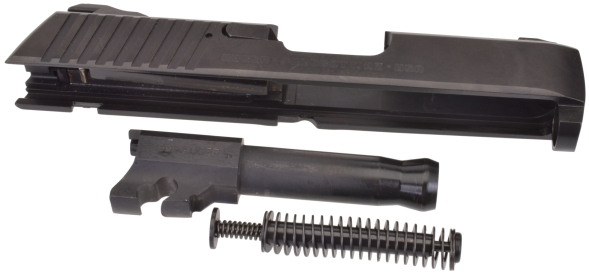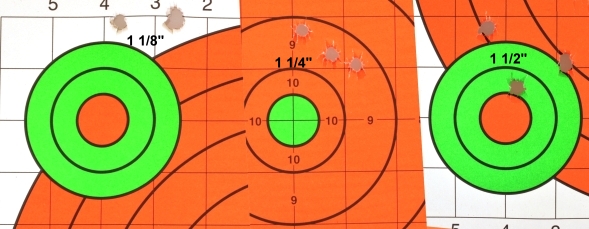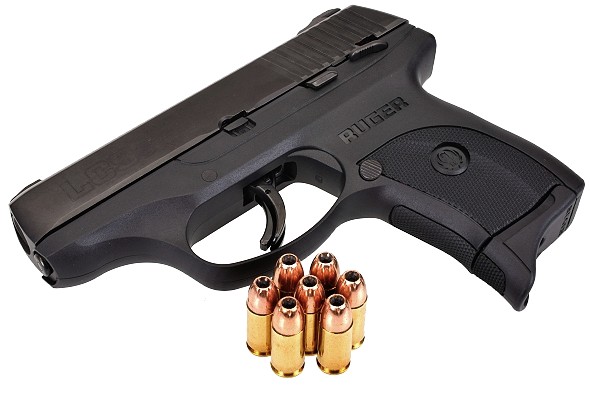
Ruger succinctly describes the LC9s as, “…a compact, centerfire, single-strike, striker fired, magazine-fed, autoloading, recoil-operated pistol”. Like the LC9, the LC9s is chambered for the 9mm Luger cartridge. Like the LC9, the LC9s has a fiber-filled Nylon frame, aluminum subframe and a steel slide. However, where the LC9 has a preset hammer, the LC9s has a preset striker. In making this change, Ruger addressed what many felt detracted from the performance of the original LC9, its long, uneven and heavy trigger pull. So the trigger is probably a good place to begin.
| Model | Overall Pull |
Take up Pull |
Take up Effort |
Active Pull |
Active Effort |
| LC9 | 0.9″ | 0.6″ | 2.0 Lbs. | 0.3″ | 6.0 Lbs. |
| LC9s | 0.4″ | 0.2″ | 2.0 Lbs. | 0.2″ | 4.8 Lbs. |
As an improvement over the LC9, the LC9s’ trigger travel is less than half and pull weight has dropped from 6.0 Lbs. and a little mushy to 4.8 Lbs and pretty crisp. Quite a change. Some folks will still grouse about this pull weight and the fact it doesn’t feel like a single action 1911 with 0.020″ of hammer/sear engagement. However, folks who understand that a striker’s trigger must perform tasks like compressing the striker spring will appreciate the design change.
Ruger published figures for the LC9s’ trigger differ from ours a bit with Ruger showing about a 1/2 pound heavier trigger and a trigger that travels 0.050″ further. Our references were taken from the subject pistol. Could just be the difference between a specific pistol and nominal specs. Could be we shop for pull gauges and calipers at different places. I don’t think the difference is significant because the change to a short, crisp trigger pull trumps a modest difference in pull ounces.
External features
One item not found on the LC9s that was present on the original LC9 is an internal key activated lock. I am not a anti-safety system evangelist, but I won’t miss it because I never used one. If I need to secure a firearm, I lock it up in a safe. If I am carrying, I can think of no reason for keeping it locked. One item found on the LC9s and not on the LC9 is the trigger safety that comes with the change over to striker firing.
The LC9s is intended for self-defense and/or concealed carry; it is not intended to be a target pistol. Subsequently, all of the pistol’s systems and features are configured for those applications. As an example, the slide at the ejection port is open at the top to minimize the chance of jamming and to make it easy to clear one in the event something does get in the way of normal operation.

The front and rear sights are of a low profile type that forms a three dot system. Dovetail mounted, the rear sight is windage adjustable, the front sight is not. For folks with other sight type preferences, fiber optic sights, tritium sights and both grip and under-barrel mount laser sights are available from the Ruger Store. For something a little more exotic, like a Tritium/Fiber Optic combo, try Brownells for a set of TruGlo Bright-Sites.
 The pistol’s thumb activated safety and a firing pin blocking trigger safety prevent unintended discharge. There is a magazine disconnect that prevents the pistol firing if the magazine has been removed. A loaded chamber view port simplifies checking the chamber for a loaded condition.
The pistol’s thumb activated safety and a firing pin blocking trigger safety prevent unintended discharge. There is a magazine disconnect that prevents the pistol firing if the magazine has been removed. A loaded chamber view port simplifies checking the chamber for a loaded condition.
A take down plate covers the take down pin and is lowered for disassembly. When new, it takes two men and a small boy to remove the pin, but after a time in use, one man can be dismissed. For anyone interested, this special pin removal tool in available in chrome and decoratively colored versions.
The slide hold open, of course… holds open the slide. The slide also remains open when the last shot is fired to facilitate reloading.
The pistol is supplied with a soft case and 7 round magazine with both standard and finger extension magazine floorplates. The extended finger floorplate does provide support for an extra finger on the grip. The LC9s is also supplied with an inert magazine. Because the LC9s has a magazine disconnect to prevent the pistol from being fired without a magazine inserted, the insert magazine facilitates safe disassembly and safe dry fire.

Looks familiar…
The LC9s recoil spring is a little different from the LC9 piece. Both are dual spring assemblies, however, the LC9s spring set is captive. The barrel and slide are blued alloy steel. The slide’s leading taper makes for easier holstering and unholstering.

The LC9s, like the LC9, is a locked breech, tilting barrel design, which basically means that the breech is locked closed when the gun is discharged but, when the bullet leaves the barrel, the rear of the barrel cams down and allows the slide to travel full open and full closed to eject an empty case, load a fresh round, reset the trigger mechanism and preset the striker.

The fiber filled nylon frame is well reinforced with ribbing, an aluminum subframe maintains critical mechanical dimensions and orientation. The pistol feels substantial…. steady in the hand. Overall it specs like this –
| Specifications | Ruger LC9s |
| Manufactured | Prescott, AZ |
| Model | 3235 |
| Frame | Fiber Filled Nylon |
| Slide/Hardware | Blued Alloy Steel |
| Type Action | Single Strike/Striker |
| Caliber | 9mm |
| Capacity | 7+1 |
| Trigger Pull | 4.6 Lbs. |
| Barrel Length | 3.12″ |
| Rifling | 1:10″ RH |
| Sights | Rear Adj Three Dot |
| Overall Length | 6.00″ |
| Overall Height | 4.50″ |
| Thickness “ | 0.90 |
| Weight Oz. | 17.2 |
| MSRP | $449 |
If you are familiar with the original LC9, you’ve probably noticed the LC9 and LC9s are near dimensionally the same. Subsequently, the LC9s utilizes all of the same holsters, sights and accessories as the original LC9. Magazines interchange between the LC9 and LC9s, both 7 round and 9 round +2 extended base with one caveat. The original LC9 has a slightly thicker grip contour than the LC9s. As a result, if the 9 shot LC9 +2 extended base is used with the LC9s, there will be a slight grip mismatch where the magazine meets the pistol’s grip frame. A new 9 shot magazine will be available in a few weeks that will be a perfect match for the LC9s.
Shooting personality…
The LC9s was shot with the sights set as received. No adjustment was made as changes in ammunition type shifted point of impact. The only interest was collecting group size data at 10 yards. Ammo shot was… Left – PMC Bronze 115 Grain JHP, Center – Remington Golden Saber 124 Grain Brass JHP, Right – Hornady Critical Duty 135 Grain FlexLock. The LC9s is a relatively easy gun to shoot. While compact and light, it is manageable under recoil and rapid follow up shots grouped closely on target.

The LC9s is approved for standard and +P pressure ammunition. It is not approved for +P+ for the same reason other manufacturers withhold approval. There is no +P+ pressure standard. It is an invention of cartridge companies that produce ammunition that operates beyond SAAMI or CIP pressure ceilings. Since there is no standard, a manufacturer would be giving blank check approval to an unknown condition if they approved the use of “+P+” ammo.

The LC9s, like the LC9, is a sound pistol. It did not jam, hiccup, burp, or sputter though days at the range. The new trigger clearly makes this autoloader a winner. Is there something I would change? Sure. Why not? Being picky, I would put a little height on the magazine release so it could be dropped without shifting grip to any great extent. Very nice autoloader. I’d guess Ruger will sell them like jelly beans. It is a well made, easily concealable, highly reliable, and value priced.

Email Notification